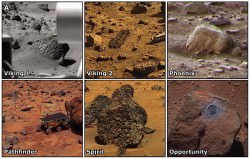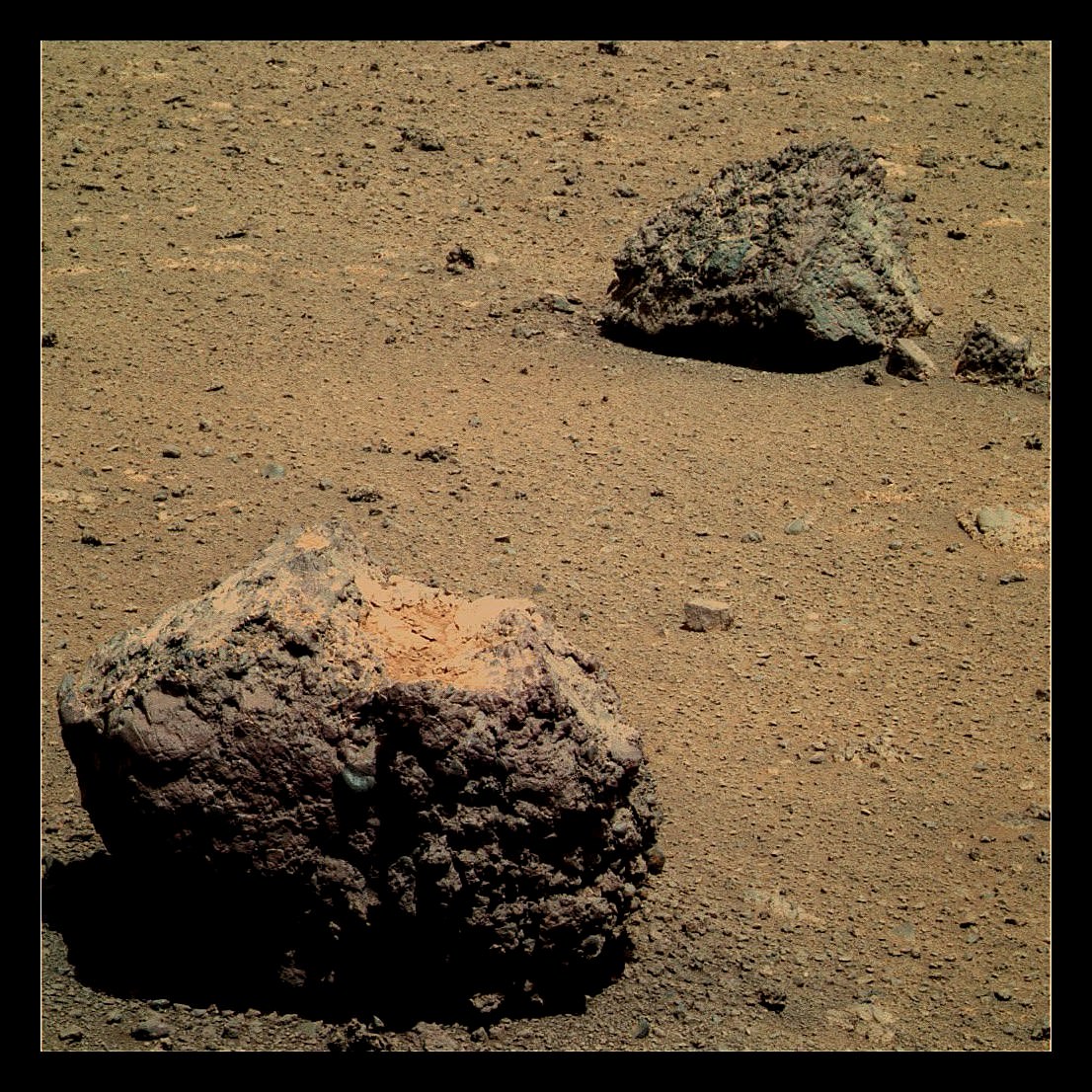[/caption]
There are many ways rocks can be textured. Wind erosion, water erosion, the escape of volcanic gases during their formation (in the case of igneous rocks)… all these forces can create the pitted textures found on many rocks on Earth… and perhaps even on Mars. And according to a report published by a group of planetary geologists led by James Head of Rhode Island’s Brown University, another method may also be at play on Mars: melting snow.
Here on Earth in the hyper-arid dry valleys of Antarctica, water from melting snow erodes the surfaces of dark boulders, creating pitted textures similar to what has been found at many locations on Mars.
In order for that process to be truly analogous, though, a few conditions would have to be met on the red planet. First, the atmospheric pressure must be high enough to allow water to remain – if only temporarily – in a liquid state. Water that instantly boils away won’t have enough time to chemically attack the rock. Second, the rock itself must be at least warm enough to not freeze the water (again, must be liquid.) And third, there must actually be water, snow or frost present.
 While one or more of these factors may be currently present in locations on Mars, they have not yet been found to exist all together in the same place. But that’s just what’s been found now… in Mars’ geologic past these may all have very well existed either in isolated locations or perhaps even planet-wide.
While one or more of these factors may be currently present in locations on Mars, they have not yet been found to exist all together in the same place. But that’s just what’s been found now… in Mars’ geologic past these may all have very well existed either in isolated locations or perhaps even planet-wide.
The paper’s abstract states:
For example, increases in atmospheric water vapor content (due, for example, to the loss of the south perennial polar CO2 cap) could favor the deposition of snow, which if collected on rocks heated to above the melting temperature during favorable conditions (e.g., perihelion), could cause melting and the type of locally enhanced chemical weathering that can cause pits.
In other words, if the dry ice at Mars’ south pole had melted at one point, freed-up water vapor could have fallen on rocks elsewhere as snow. If Mars were at a point in its orbit closest to the Sun and therefore experiencing warmer temperatures the snow could have then melted – especially upon darker rock surfaces.
Still, it’s possible – or even probable – that the weathering did not occur at a consistent rate across the entire surface of the rocks. Some sides may have weathered faster or slower than others, depending on how they were exposed to the elements. But if there’s one thing Mars has had a surplus of, it’s time. Even if the processes outlined in the report are indeed the cause of Mars’ pitted rocks, they have likely been in play over many hundreds of millions – even billions – of years.
Read the team’s report on the Journal of Geophysical Research here.
Thanks to Stu Atkinson for his color work on the images from Opportunity. Check out his blog The Road to Endeavour for updates on the rover’s progress.


Dr. Levin, while searching for answers and explanations of his positive Viking LR life detection experiments on Mars, suggested something very similar years ago (a diurnal water cycle on Mars).
“But if there’s one thing Mars has had a surplus of, it’s time.” thats a key statement and applies for biology as well. Any Martian organisms had plenty of time to adapt to the current Martian environment and its low level water cycle. Have a close look at the rocks and soils around the Endeavor crater rim. One things is sure: the greenish patches on some Martian rocks and soils recognized by Levin (Viking) and Stoker (Pathfinder) keeps reappearing now in Opportunities images like the one in this article. I wonder if somebody repeats the chlorophyll spectral scans Dr. Stoker applied to Pathfinder images (positive results) of such patches in Opportunity images.
Unfortunately the oxidizing atmosphere would break down any biomolecules that were exposed to it, so it is unlikely cellular life would be visible.
[I would think a better chance would be the color shifts that are seen as yearly recurring streamers, unless all of it is dampness and other mineralogical changes associated with brine effluents.]
Also, chlorophyll is peculiar to our evolutionary path and a complex but in some ways efficient antenna complex. I wouldn’t expect evolution to repeat its spectral absorption characteristics (absorbing both low and high energy photons) anywhere else.
But of course we should look.
I can’t get enough Mars data! Thanks Jason…
The relatively recent findings of subsurface water ice on Mars ( http://science.nasa.gov/science-news/science-at-nasa/2002/28may_marsice/ ), combined with this week’s release of a much wetter upper atmosphere from the Mars Express mission ( http://www.physorg.com/news/2011-09-supersaturation-martian-atmosphere.html ) supports this position quite well.